Strawberries are a delicious addition to any garden and provide a sweet treat. However, growing Strawberries at home can be incredibly beneficial. Strawberries are one of the fruits suitable for small spaces. They grow as a low ground cover; they can even be cultivated in window planters.
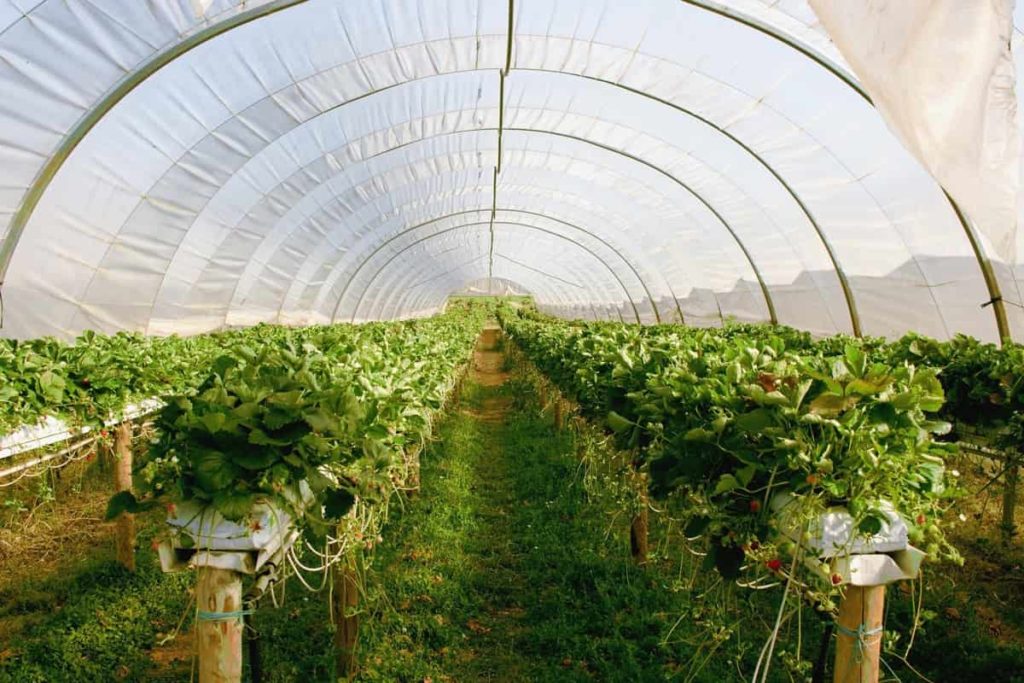
Store-bought varieties can’t match the taste of homegrown Strawberries; they’re just delicious. Depending on the variety of Strawberry plants you choose, you may get fewer berries or smaller fruits. Other factors such as crowded spacing, fertilization, and environmental conditions can all affect fruit growth on your Strawberry plant.
Growing Strawberries from seed to harvest
Should I start Strawberries indoors?
- Growing Strawberries indoors allows you to control factors like light and temperature and ousts all the pesky outdoor critters whose sole purpose is to keep you from your Strawberry shortcake.
- Since Strawberries are perennials, the plants will return every year. Bareroot Strawberries can be planted any time after last spring’s frost or earlier in the fall than expected in the winter.
- Start any time between December and early February. Even after that time, they will produce plants, but berries cannot be grown during the first season. So transplant out at least three weeks after the last frost.
- Sow the seeds thinly, press the seeds into the moist potting soil in the seed starter tray, and barely cover the seeds with a growing mix. Place the tray under the growing lights, as Strawberries need light to grow. Allow several weeks to grow. Seeds can germinate anywhere from 7 days to 6 weeks.
How long does Strawberry take from seed to harvest?
- Growing Strawberries from seeds is relatively easy and inexpensive. Strawberry plants can produce fruit for up to four or five years. However, the disease may reduce crop yields dramatically after the first two or three years.
- It takes about three months for a bare root Strawberry plant to bear fruit. Seed-grown Strawberry plants will produce fruit in their second summer because the plant needs its first year to establish and grow.
- The fruit is usually ready for harvesting 4 to 6 weeks after bloom. Just harvest the entirely red berries, and pick them up every three days. Do not pull the berry, or you may damage the plant.
- The June-bearing varieties take about four weeks to pick fruit from flowering plants. Day-neutral and ever-bearing varieties begin to flower around the same time in spring and take about the same time between flowering and harvest.
In case you missed it: How to Prepare the Soil for Strawberry Plants: Best Soil Mix, pH, Compost, and Recipe
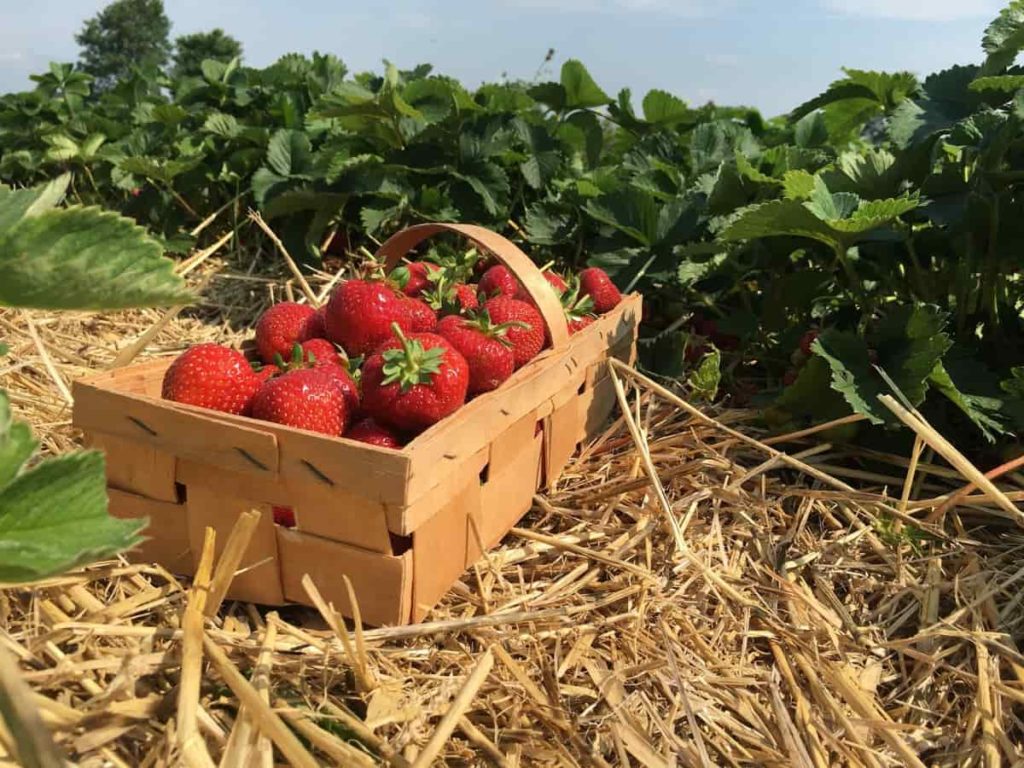
How long does it take to grow Strawberries in a greenhouse?
- Even if you grow Strawberries in a greenhouse, it won’t change the bearing times of the plants much. Therefore, choosing the right type of plant is very important for your year-round Strawberry supply.
- Midseason Strawberries start bearing fruit about eight days after the Early Season varieties. Late Midseason Strawberries will bear fruit about ten days after the early season varieties. Late Season Strawberries will prepare their berries about 14 days after the early season varieties.
How many Strawberry seeds do you need to grow a Strawberry plant?
- You can propagate Strawberries by planting runners, by seeds, or through roots.
- Place 3 to 4 seeds in each cell, directly above the soil. Gently press down the seeds, but do not cover them with soil. You should mist the top of the soil with water and barely keep it moist until the Strawberry seeds germinate.
Do Strawberries need full sun?
- Strawberries need full sun to produce more fruits. The very best tasting fruits grow in full sunshine. Pick a sunny shelter site in fertile, free-draining soil that’s ideally slightly acidic.
- Ten or more hours of sunlight every day is ideal, but they require at least six hours of direct sunlight per day.
- Growing Strawberries requires temperatures between 10°C to 26°C and less than 14 hours of daylight to produce Strawberry flowers and fruits.
How many Strawberries do you get per plant?
- Depending on the selected varieties, a single Strawberry plant will produce 40 to 70 berries throughout the season. This equals the fruit weighing between 0.7 to 1.4 kg. And this is only when it is in good production mode, with good growing conditions. The truth is that one plant will never be enough, even if only for one person.
What month do you plant Strawberries?
- You can grow fresh Strawberries in your home in easy steps. As these fruits grow in hot, sunny weather, March or April is the perfect time for your Strawberry plants. Caring for sweet berries is easy if you have some basket gardening equipment and sunny, outdoor space is available to grow them.
- For planting Strawberries, Spring is the best time, several weeks before the last frost date. You can spread your harvest from late spring to early autumn by choosing a range of Strawberry varieties.
How many times will a Strawberry plant produce?
- Ever-bearing varieties produce two crops, one in early summer and the other in early fall. Day-neutral plants produce fruit for most of the growing season.
- Try day-neutral Strawberries, an annual crop that continues to produce sweet, flavorful berries from late June to mid-autumn. Unlike June-bearing Strawberries, which produce bursts of fruits for 3 to 4 weeks starting in mid-June, Day-neutral Strawberries continue to produce new flowers and fruits throughout the season.
Do Strawberries come back every year?
- Strawberry plants are perennials, so they will return every year. The average Strawberry plant is about six years old, although, after the first two, there will be a notable drop in the fruit they produce.
- Strawberries are perennials and will grow back in the spring if the plants are healthy. Although the leaves of Strawberry plants can die in winter, the roots can survive cold temperatures. Strawberry plants will regrow from their roots yearly, provided the roots are healthy and survive winter.
- Strawberries are cold-hardy for the most part, and mild freezing temperatures will survive without many problems. So, in areas with mild winters, there may be no need for any care.
When can Strawberries be planted outside?
- Strawberry plants can be planted in an unheated greenhouse or polytunnel next spring in the fall. They can be planted for harvesting a few months later in March. Strawberries can be planted in early December, producing pickable fruits from late March if grown in a hot greenhouse.
- Plant in moist soil in mid-spring or late summer/early autumn. You must dig a hole and trim the roots lightly to 4 inches if needed, then spread them out.
In case you missed it: 20 Common Strawberry Plant Problems: How to Fix Them, Solutions, and Treatment
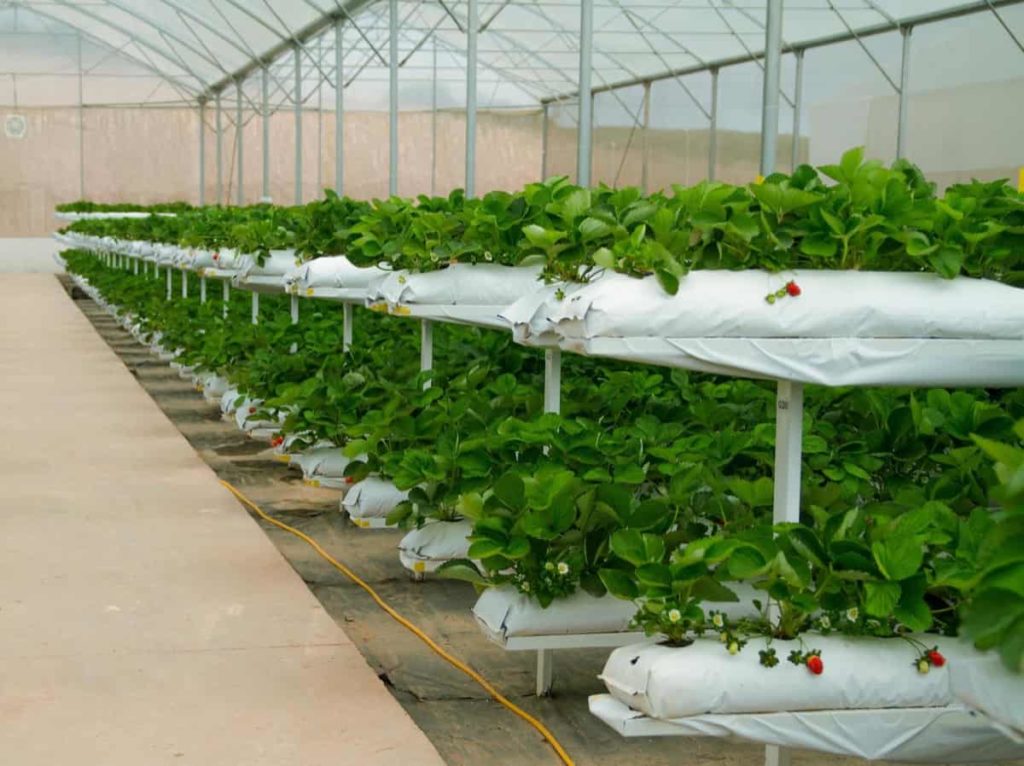
How many times do you water Strawberry plants?
- During the fruiting season, Strawberry plants require regular water to thrive when they need an average of 1 to 2 inches daily.
- Early morning is the best time for effective Strawberry irrigation. This way, the plants have to dry all day before evening. Also, check the humidity daily if you’re growing Strawberries in containers; the potting mix will dry rapidly, especially during hot weather.
What is the best way to grow Strawberries?
- Strawberries require a slightly acidic soil of 6 to 6.5. Ideally, about a month before digging in manure and well-rotten animal manure. Fortnightly water with a liquid seed solution to improve the vigor of your plants.
- Raised beds, gardens, and containers are all the best growing areas in the ground. Give room for runners by planting Strawberries at a distance of 18 inches. Strawberries can be grown in various ways, but make sure they get eight or more hours of sunshine and are applied in slightly acidic soil with a pH of 6 to 6.5.
What is the best fertilizer for Strawberries?
- You should choose a well-drained, high-quality potting soil or potting medium to plant your container Strawberries. If possible, choose one that contains fertilizer. Mix the fertilizer in a potting medium if it does not already contain it. Do this before filling the container. Since fertilizer rates vary, apply according to label instructions.
- Strawberry plants rely heavily on nitrogen. You can only use nitrogen-containing fertilizers such as urea or ammonium nitrate. Another option is to use balanced fertilizers.
- If Strawberries are grown in pots or hanging baskets, feed them with a balanced fertilizer every two weeks during the growing season. Turn to a high potash liquid fertilizer to encourage fruit picking when flowering begins.
- You should fertilize Strawberries established after the final harvest once a year. You should fertilize in spring because it can result in soft berries and excessive vigorous growth that can increase the incidence of the disease.
Can Strawberries grow in pots?
- Strawberries can adapt to various containers, from 6 to 8-inch pots for individual plants to large planters such as wooden or plastic half barrels for multiple plants. They also grow in hanging baskets and window boxes.
- Strawberries grow best in pots that are in full sunshine and filled with high-quality potting mix compost blend. Do not crowd them in the container, leaving at least 8 inches between the plants.
- Your plants will likely need to be replaced almost every three years when their yield decreases and they begin to die. However, you can cut down runners and give them space in the pot to create new Strawberry plants for free.
- You can grow Strawberries in containers; it can shorten the plant’s lifespan. Window boxes, flower bags, and hanging baskets are fine for a single growing season.
- The best pots for Strawberries are those that are urn-shaped, with holes under the sides in variable areas. Although the holes make the pot look like dirt, water, or even a plant, these pots are perfect for growing Strawberries in containers.
What kind of soil does Strawberries like?
- Strawberries grow best in deep, sandy loam soils rich in organic matter. The soil should be well drained. Stay away from areas that remain wet for a long time in spring.
- Before planting, prepare the soil by adding two to three inches of compost or other organic matter at least 12 inches deep. Organic matter improves nutrient availability, soil structure, and ability to hold water.
Should you pick the first flowers off Strawberry plants?
- After planting, pinch the buds of any flower that appears for the first few weeks. This will allow the Strawberry plant to produce more leaves and roots, so when the flowers are pollinated and start producing fruit, the plant has enough energy to produce large, juicy Strawberries.
- All flowers should be removed from June-bearing Strawberries during the first growing season. If flowers are allowed to grow in berries, their growth will reduce the growth of plants, the production of runners, and the size of next year’s crop.
- If you’re growing ever-bearing Strawberries, pinch all the flowers from the year-old stock planted last April to encourage plant growth and save energy for the harvest in late summer or early autumn.
How do I keep bugs from eating my Strawberries?
- Cover Strawberries with floating row cover in summer to prevent adult insects from laying eggs in Strawberries. You can use a homemade spray made from garlic or hot pepper mixed with water to spray the plants. In addition, you can use neem oil or citrus-based insect oil to prevent infection.
- The best way to protect Strawberries from birds is to drape a Strawberry patch with a bird net, an inexpensive plastic mesh with ¼-inch holes.
- Mix vinegar with water in a 1:3 ratio and spray it on your Strawberry plants to kill the aphids. Be careful to cover the stems and bottoms of the leaves where the aphids like to hide. Repeat the process after a week to kill them all.
- If the number of aphids appears to be increasing, spraying an insecticidal soap will help reduce aphid numbers with minimal harm to natural enemies.
In case you missed it: Best Fertilizers for Strawberries: Homemade, Organic, Compost, Liquid, NPK Ratio, and Schedule
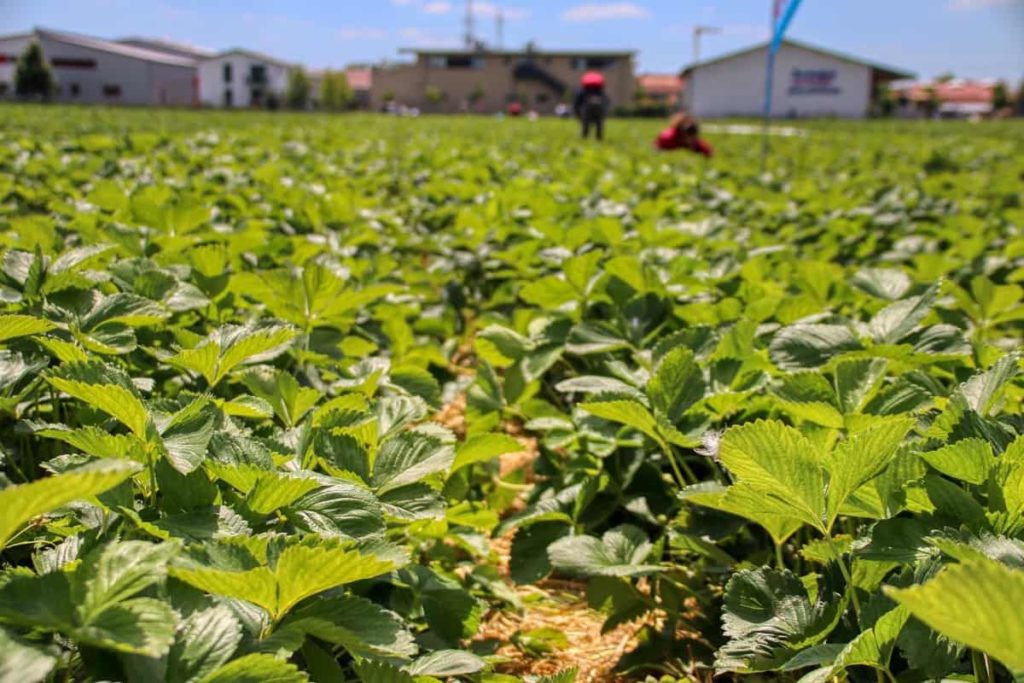
Can you plant different Strawberry plants together?
- If you’re familiar with their growing habits, especially for runner-producing cultivars, it’s possible to mix Strawberry varieties in your garden. A typical 12 to 14-inch hanging pot or basket can accommodate two to three plants.
- The space plants are at a distance of 12 to 18 inches. Strawberries themselves are fertile, but flies are needed for pollination. Remove a few runners throughout the season, or your Strawberry plants will take over your pot.
Can I plant a whole Strawberry?
- You may try, but Strawberries contain a lot of water, and they decompose quickly, so if you just put one Strawberry straight into the soil, it’s more likely that Strawberry flesh with rot and mold will also destroy the seeds before they have a chance to sprout.
- If you plant whole Strawberries, they won’t grow because they will rot or be eaten by insects, birds, or other critters before the seeds sprout. But you can chop the Strawberries, dry them in a warm room, and then plant the seeds after keeping them in the freezer for three to four weeks.
- On average, there are 200 seeds in a Strawberry. In addition, they are the only fruit to wear your seeds from the outside. Therefore, the distance of Strawberries affects crop yield and fruit size. In addition, diseases can travel more easily to plants if plants are spaced closely together.
Is Epsom salt good for Strawberries?
- Epsom salt is good for Strawberry plants because it helps them make more food, improves plant growth, and keeps them healthy.
- Add about a teaspoon of Epsom salt to a gallon of water. Let the solid dissolve completely and water your plants as usual. After a set of flowers and fruits, you can use dissolved salts to feed your plants. This should help in producing larger berries.
- Epsom salt may also help prevent pests. Sprinkle salt around the base of the plants if you’re dealing with garden pests like snails and slugs.
Are eggshells good for Strawberry plants?
- Eggshells can help Strawberry plants grow well by adding calcium to the soil. Crush the eggshells into a fine powder to help your plants enjoy their nutrients.
- Wash your eggshells, and let them dry on a paper towel. Grind the shells into an old coffee grinder to produce smaller particles. Once that’s done, you can add them to your garden. Or, boil about 20 eggshells and let them sit in the water overnight. After that, use the strained water as a liquid calcium solution.
In case you missed it: Growing Strawberries In Greenhouse – Polyhouse

How do I encourage Strawberries to fruit?
- If your Strawberry plants are not producing, they may be very young. Most varieties produce very little fruit within the first year. Plants instead focus more energy on establishing strong roots.
- If the temperature rises too high, the plants stop producing, even if they are an ever-bearing variety. The best temperature for growing Strawberries falls between 16 to 26°C, but if it gets consistently heated to 26°C, plants stop producing fruit and may even die.
- From early spring, encourage flowers and fruits by feeding your Strawberry plants high potash feed every week or two.
- Strawberries perform well in drained, fertile, and slightly acidic soils. These plants produce higher yields and are sweeter when grown in fertilizer-rich, sandy soils. Plant Strawberries in raised beds is also a good idea, as it ensures better drainage.
What can you not plant near Strawberries?
- Plants such as Tomatoes, Brinjal, Potatoes, Melons, Peppers, Roses, Mint, and okra can contribute to the deadly disease in Strawberry plants.
- Avoid planting Brassica such as Kale, Cauliflower, Broccoli, Bock Choy, and Cabbage near your Strawberry. When trying to grow Brassicas family members with Strawberries, you’ll find that it’s a terrible combination because they’ll compete for nutrients and won’t allow thriving to their full potential.
- Fennel can be great for preventing pests; however, it can potentially inhibit growth, made less than ideal for Strawberries you want to grow with abundant nutrients, vitamins, and sweet, juicy flavors.
Is a greenhouse too hot for Strawberries?
- The benefit of growing Strawberries in a greenhouse is that you don’t have to agonize over frost. A temperature of about 15°C should be maintained until the plants begin to flower.
- Your greenhouse will protect your Strawberries from sudden frost and dangerously cold temperatures, which is one of the best benefits. Pre-flowering Strawberry plants should be placed above 15°C, and they should get as much sunlight as you can give them during the fruiting period.
- A cooling phase is very important for stimulating flowers in the next season. Strawberries grown in greenhouses prefer a day temperature lower than 25°C. The ideal temperature range for greenhouse Strawberries is 18°C to 24°C. However, the temperature should not exceed 25°C as high temperatures can negatively affect growth.
How often do you water Strawberries in a greenhouse?
You’ll need to water a little daily to keep the soil moist unless you have a self-watering planter. It is recommended that the water is only in the morning to minimize the length of time that the soil gets too wet. You can feed your Strawberries with balanced, organic fertilizer every two weeks during the growing season.
What’s the best way to grow Strawberries in a greenhouse?
Strawberries require plenty of sunlight and dry conditions to thrive, which is one of the great benefits of growing them under glass. Aim to give them as much sunlight as possible, which should be at least six hours a day; you can help ensure this by keeping the panes clean and clear.
In case you missed it: Growing Organic Strawberries On Terrace – In Pots
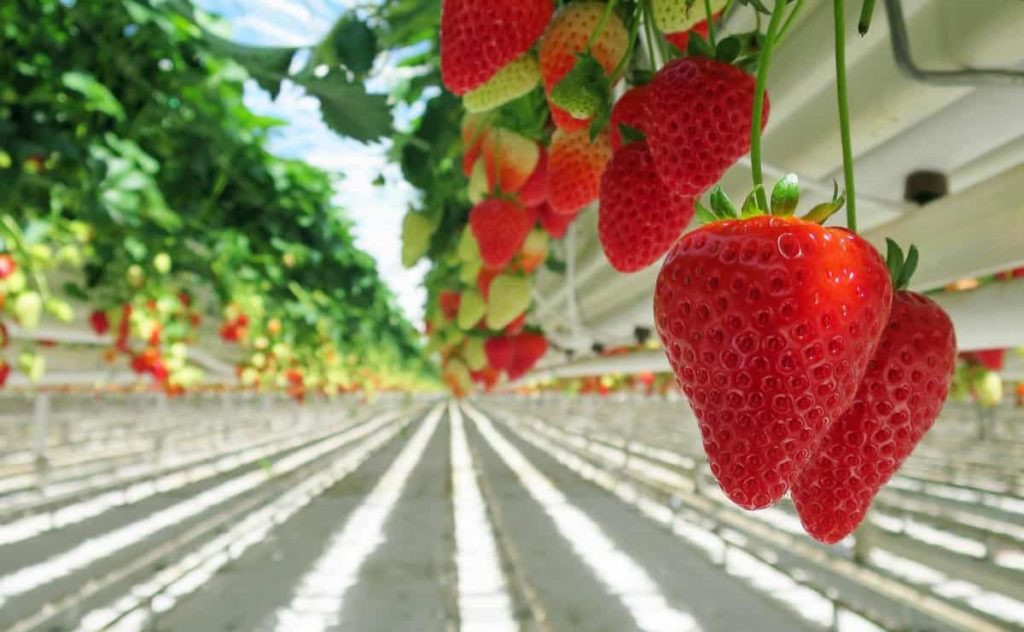
How do I get my Strawberry plant to produce more fruit?
- Make sure your Strawberries are planted in nutrient-rich soil. Strawberries grow best in slightly acid in neutral soil with a pH of about 6.0 to 6.5.
- Make sure your Strawberry plants are getting the right amount of water. Strawberries have a system of shallow roots, so they get most of their water from the top two inches of the soil, which is also the soil that dries out the fastest.
- Feed your Strawberries the right kind of plant food. Strawberries won’t grow well without nutrients, but if given too much nitrogen, they’ll grow too many leaves without flowering.
- Every year, your Strawberry plant produces runners. Runners have long stems that run from the main plant and form more Strawberry plants.
- Attract flies to the yard to help pollinate your Strawberries. Plant flowering shrubs, trees, and flowers nearby early in the season to attract bees to your yard and give them a reason to return to the area.
- Make sure your Strawberry plants are free of pests and diseases. Plants fighting disease or parasites will not have much energy to produce flowers and berries.
Conclusion
Strawberries are well suited for home gardens because they produce fruit easily and require a relatively small amount of space. Although fresh Strawberries are available in grocery stores in spring and summer, there’s nothing like eating freshly picked Strawberries out of your garden.
- Flower Garden Designs and Layouts for Beginners
- Planting and Spacing Techniques in Papaya: A Beginner’s Guide
- Growing Gold: Essential Techniques for Planting Pineapples
- How to Make Kalanchoe Plant Bushy: Home Remedies and Solutions
- 11 Reasons Why Your Gardenia is Not Blooming: Home Remedies and Solutions
- Eco Elegance: The Guide to Designing a Drought-Tolerant Landscape
- Gardening on a Slope: Strategies for Hillside Landscaping
- Nourish and Flourish: Top Organic Mulches for Thriving House Plants
- Everything You Want to Know about Indian Mogra Flower: Discover Uses and Growing
- Green Thumb Success: Expert Tips for Cultivating Greenhouse Pumpkins All Year Round
- Maximize Growth & Flavor: The Ultimate Guide to Companion Planting in Herb Gardens
- How to Control Rhododendron Problems Naturally: Home Remedies and Organic Ways to Fix Them
- Natural Magic: The Remarkable Benefits of Cinnamon for Plants
- Best Steps to Revive Dying Tulip with Natural and Organic Treatment
- 10 Reasons Why Your Angel Trumpet is Not Blooming: Remedies and Treatment
- How to Fix Periwinkle Leaf and Flower-Related Problems: Natural Remedies and Solutions
- How to Fix Zinnias Leaf and Flower Problems: Discover Natural and Home Remedies
- Organic Steps to Induce Lemon Tree Flowers: A Comprehensive Guide
- Bloom Booster: Crafting the Perfect Homemade Bougainvillea Fertilizer
- Optimizing Growth: A Guide to Applying NPK Fertilizer for Potted Plants
- 10 Best Homemade Fertilizers for Rubber Plant: DIY Recipes and Application Method
- How to Boost Female Pumpkin Flowers: Effective Steps for More Flowers and High Yields
- Transform Your Indoor Garden: Top Benefits of Pink Salt for Houseplants
- 10 Best Homemade Fertilizers for Peacock Plants (Calathea): Easy DIY Guide
- Unlock Blooms: 9 Reasons Why Your Potted Chrysanthemum is Not Blooming
- 8 Reasons Why Your Potted Hibiscus is Not Blooming: Fix it with Simple Solutions
- Unlock Blooms: 9 Key Reasons Your Potted Frangipani Won’t Flower
- 10 Reasons Why Is My Ice Plant Not Blooming: Remedies and Treatment
- 10 Reasons Why My Potted Hydrangea Not Blooming: Treatment and Remedies
- 10 Reasons Why is My Wisteria Not Blooming: Remedies and Treatment
- 10 Reasons Why is My Goldfish Plant Not Blooming: Remedies and Treatment
- Maximize Your Space: Ultimate Guide to Balcony Gardening with Grow Bags
- 10 Reasons Why Your Iris is Not Blooming: Remedies and Treatment
- 10 Reasons Why Your Anthurium Plant is Not Blooming: Treatment and Remedies
- 10 Reasons Why Your Aquaponic Plants Are Not Flowering: Remedies and Treatment
- 10 Reasons Why Your Agapanthus is Not Flowering: Remedies and Treatment